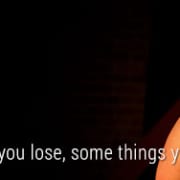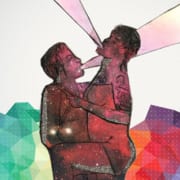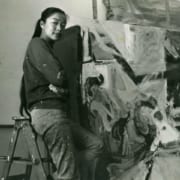FACE by Jewelle Gomez
FACE by Jewelle Gomez
In some animals, including humans, looking directly into another’s face is a sign of aggression. Meeting eye to eye implies confrontation. Our fur bristles and adrenaline flows. To face down, face off–each are euphemisms for trouble. But why doesn’t meeting the gaze of another suggest curiosity instead? How can we as people and as artists ever know the world around us without close examination and exploration. The face, whether painted, pierced or mutilated, is a door to us, an opening to who we might be. but the door is one we often seem determined to lock tight against all. As queers in U.S. society our political impulse has careened wildly between burrowing into the anonymity of a shadow world on one hand and on the other–grabbing every light source within reach to put an end to our invisibility. Almost 30 years after the U.S. queer movement found it’s iconographic moment–Stonewall–we’re still trying to find out who we are behind the marches and slogans. Not just who should represent us, but what is the “us.” Are we the blond and abashed Ellen, the dark objects of Mapplethorpe’s gaze or the sisters of Perpetual Indulgence? Would Radclyff Hall, Cole Porter or James Baldwin ever invite us over for cocktails? What do we look like?
It’s difficult to answer that question without an extended, penetrating look–face to face. To take such liberty is frightening. Seriously examining things close up means letting go of what’s in your head and actually attempting to perceive something outside yourself: free from the preconceived image you already carry. Audre Lorde wrote: “To search for power within myself means I must be willing to move through being afraid to whatever lies beyond.”
When an artist sits down before her “tools”: in front of a typewriter, a canvas, a stage, behind a lens or with instrument in hand, she is also in front of a mirror. It is the looking glass which will help move her through her fears. The words spilling across the page are a reflection of who the writer is–her dreams, anxieties, ambitions and desires. And when the writer or any artist allows the inner core to be exposed it shines white-hot, burning an enduring image for all to see.
We each hunger not just for visibility, but to be more profoundly perceived. The gaze turned fully toward our artistry and our queerness allowing us to be object, subject and participant. When we risk facing each other head on, we risk losing what we think we know and learning something new. In thrusting ourselves into the light, eyes front, no compromises we move closer toward a deeper perception of “the other;” and we ultimately provide the opportunity of really seeing ourselves. Let’s face the music, and dance.
Jewelle Gomez © 1998




